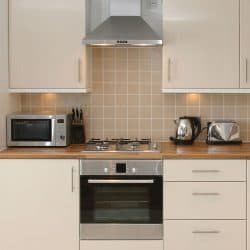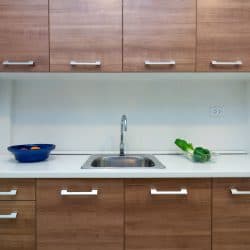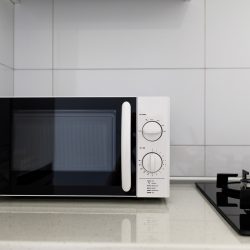Are you remodeling your kitchen? If you're considering new cabinets and appliances, you might be surprised that how these things are placed next to each other is important. This is especially true when you are dealing with kitchen cabinets and stoves. We sourced information from various professional sites so that you'll know exactly how much space you should leave between a stove and a cabinet and why.
Building codes do not require any spacing amount between your stove and the cabinets on either side of it. It is recommended that you leave between 24" and 30" of space between the top of your stove and the above cabinet. Spacing between stoves and other kitchen objects is essential for both safety and best kitchen practices. These include recommended space between your stove and your:
- kitchen sink
- microwave
- other appliances
- cabinets on the opposing wall
Now that we know what professionals recommend, we'll break down the distances further throughout the rest of this post. Our research will also cover the standard size of stoves if you can safely place a stove inside a cabinet, and other questions you might have. Read ahead to see what we've discovered.

Why clearance between your stove and other objects is important
Allotting for the proper amount of space between your stove and the items mentioned above will make your kitchen safer and enable you to work more freely while preparing meals. How much room will you need?
Kitchen sink
It's essential to have some space between your kitchen's sink and your stove. Professionals will recommend that you allow for 24" to 30" inches between these two objects. This will keep water from hitting your stovetop and give you counter space to prepare food.
Microwave
We'll cover microwaves more in detail later in this post. Depending on the type of microwave you have, you'll want it to be at least thirteen inches from your stove.
Other appliances
Having at least four feet of space between your stove and other appliances is ideal. This will allow you to work over your stove and oven while others are simultaneously using other kitchen staples like a dishwasher or microwave. For electrical reasons, this is also recommended. For safety reasons, you don't want more than one appliance on the same circuit.
Cabinets on the opposing wall
Ideally, your kitchen will allow for at least 48" space in between the front of your stove and the cabinets' fronts on the opposite wall. This amount of space is enough for you to freely prepare food and cook while others might be doing other chores in the kitchen.
What is the standard stove size?
There isn't any standard size for stoves, but the sizes fall within specific ranges (no pun intended), which will depend upon the type of stove you're looking at. In this section of this post, we'll discuss the sizes of the different stoves you might be considering.
Apartment sized
Smaller living units will usually have specifically designed appliances to accommodate for their reduced size. Stoves are no exception to this. While they aren't too much smaller than the standard freestanding stoves, there is a noticeable difference in the dimensions.
These smaller stoves average between 34" and 44" in height, 20" to 24" in width, and 24" to 26" in depth.
To see this brand of apartment sized stove on Amazon, click here.
Standard free-standing stove
The most common style of stove for residences is the standard freestanding stove. This type of stove isn't attached to any fixture and isn't placed inside your wall like a slide-in unit.
Freestanding stoves are 46" to 49" tall, 30" wide, and 24" to 28" deep.
To see this brand of freestanding stove on Amazon, click here.
Standard slide-in
Slide-in stoves are housed inside their own specific space. They slide into place, hence their name. These are less common than freestanding stoves, but they are still readily available.
Standard slide-in stoves are between 36" and 38" tall, 30" wide, and 24" to 28" deep.
To see this brand of slide-in stove on Amazon, click here.
Commercial
Found in restaurants, bars, and other public spaces, commercial stoves are the largest of this appliance type.
Commercial stoves are between 35" to 40" tall, 36" to 48" wide, and 26" to 31" deep. The range in sizes is much greater with this type of stove since the commercial needs for using it vary significantly based upon business volume.
To see this brand of commercial stove on Amazon, click here.
How much space do you need on each side of a stove?
The amount of space you'll want to have on either side of this appliance will vary according to how much you'll be using it. It's recommended to have a minimum of fifteen to eighteen inches on both sides. This much space will allow for you to be able to shift over a hot pan or pot in a hurry and will leave you with room for cutting boards, utensil holders, and other things you'll want close by when cooking.

Can you put an oven in a cabinet?
For a more sleek and uniform look in the kitchen, some homeowners are beginning to place their ovens inside cabinets. Is this practice safe?
As ovens do not emit very much heat from their sides, enclosing your oven inside of a cabinet is perfectly fine. Of course, you'll want to ensure that you have adequately leveled the appliance inside its new housing to prevent spillage from items being cooked inside.
Since the standard width of a stove is thirty inches, you'll want to make sure your cabinet is at least thirty-one inches. Having a half-inch space between the sides of your appliance and the cabinet's interior sides allows for enough room for safety and easy removal.
How close can a microwave be to the stove?
Our research discovered conflicting recommendations between the number of safe distances between your stove and microwave.
Microwaves installed above stoves
Nearly all professional sources will state that you should have at least sixty-six inches from the floor to the top of the microwave. This places it within easy reach for most people.
These same sources claim that having a minimum of thirteen inches between the top of the gas or electric range and the bottom of the microwave is enough room.
However, various sources state that this is too close if you are using your range more than the average person or cooking things on the stovetop for long periods. They maintain that you should have a minimum of eighteen inches between the top of the range and the bottom of your microwave. Having any less space than this will do damage to your mounted appliance.
To ensure that you are allowing for enough room, read the owner's manual for both your stove and your microwave.
To see this model over-the-range microwave on Amazon, click here.
Freestanding microwaves
These units are more commonly referred to as countertop microwaves. These models have much less external heat resistance than their over-the-range counterparts. A safe distance between these types of microwaves and your stove is a minimum of two feet.
To see this model freestanding microwave on Amazon, click here.
In conclusion
In this post, we learned that you're able to place a stove next to cabinets safely, as stoves do not emit much heat from their sides. It's essential to leave at least twenty-four inches of room between the top of your stove and the bottom of any cabinet that sits above it.
There are recommended spaces between stoves and sinks, microwaves, and large appliances for safety and functionality reasons. Proper spacing will make your kitchen safer and allows for work to be done more efficiently.
We also learned that depending on the type of microwave you have; you might be able to have your stove as close as thirteen inches to it. But if you have a countertop model, you'll want to maintain a minimum distance of at least two feet between them.
We hope that you found the information in this post to be helpful. You may enjoy reading the following posts about your kitchen:
Should Kitchen Cabinets Reach The Ceiling?
Do You Tile Under Kitchen Cabinets?
Ants In Dishwasher: What To Do?
Can You Freeze Food In A Glass Container?












![A small modern kitchen with oak cabinetries, white floating cabinets, and a microwave on top of the countertop, How Big is a Microwave? [By Type]](https://kitchenseer.com/wp-content/uploads/2021/08/A-small-modern-kitchen-with-small-oak-cabinets-white-floating-cabinets-and-a-microwave-on-top-of-the-cooktop-250x250.jpg)
I am putting a 24 inch commercial stove into a 30 inch pervious stove space, thus removing the old stove, will it look funny?
is there any minimum requirement for any freestanding stove to be level up (using its levelling legs)? is it safe/recommended if we remove all the legs? i have a limited space at above, and needs to modify the height of the stove
Yep, the kitchen layout matters a lot, especially the appliances. Where to locate all these appliances to make it reasonable should be taken into consideration.